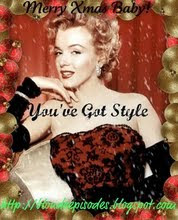To be honest, it's been a miserable winter here. The weather has been simply dreadful - and I've had several (three?) serious bouts with the flu - one of which I'm still on the mend. So I haven't had a lot to report or even spend much time cruising around the internet to find interesting tidbits to share!
But, a posting on the blog Messy Nessy Chic got me interested in the French Apache style of life and dressing - and I thought you would like to know a little about it, too! And, it was a good reason to get the blog going for the year!
We're going to take a look at this style phenomenon in the unlikeliest of settings - amidst the Parisian street gangs of the 1900's, les Apaches (pronounced ah-PASHZ, not a-PACH-ee, as in the Native American tribal name.
The Paris of the Bell Epoque saw the emergence of a certain type of street outcasts - a subculture that combined dandy style with the criminal underworld.
They lived in the city outskirts, shunned the idea of honest labor and took their names from the allegedly savage Native American tribes of Apaches. They targeted the bourgois middle class, hunting and stalking their victims before mugging them of their valuables using the special Apaches revolver as a weapon if needed (pictured below).
Abiding by their own code of honor, they woke up late, spoke the obscure slang Jare, and, most of all, paid very close attention to their style - particularly their footwear. It was their unlikely physical appearance that imposed both fear and respect from the Parisians and their police. An apache might have been holding you at gunpoint, but you - perhaps - would not have been unable to resist admiring his shoes or dandy layering.
Typical Apache style layering
Apache could steal, cheat - or kill, if necessary - to get hold of a pair of shoes that would enhance his image in the eyes of his gang or his lovers. The littlest scratch and the pair were thrown to the poor. The height of Apache vanity was a pair of freshly polished yellow boots with golden buttons.Each gang was dressed slightly differently, often wearing something such as a red scarf that would be both a sign of belonging and a means of identification in other territories.
However, certain elements were the same in all gangs. All wore a certain type of trouser, tight at the knees and flared at the bottom, known as Bénard, which is still used in Parisian slang today to designate a pair of trousers (bénard, ben' or bénouze.)
On top, the men generally wore waistcoats or jackets with sailor shirts and on their heads there was always a hat of some description, generally a flat cap or béret.
See the influence on today's street style in Paris.
Interestingly, there was even an Apache dance.
In the 1920's, many a high society lady was spotted mingling with charismatic Apache groups in local Java dance halls in Bastille and Montmarte, letting her hair down in a famous Dance Apache.The highly dramatic dance was the 'tango' of the Parisian street culture and was essentially made to look like a physical attack. Immortalized later in Hollywood and Broadway, the dance is said to re-enact a violent "discussion" between a pimp and a prostitute. It includes mock slaps and punches, the man picking up and carrying her while she struggles or feigns unconsciousness. The dance shares many features with the theatrical discipline of stage combat and also with professional wrestling.
In the video below, that will most certainly take you by surprise if you're unfamiliar with the dance moves, you'll see where modern entertainment show wrestling may have pinched its idea from and you will also recognize a few hair-raising moves that figure skating couples often use in their performances...
One of the most famous Hollywoodized - and highly sanitized versions - is the one by Gene Kelly and Cyd Cherise in "Singing in the Rain" - also of interest, the female dancer has become the 'dangerous' partner.
The Apache gangs ceased to exist after the First World War, with many members killed off in the conflict. However, bourgeois newspapers of the period and universal fascination with the underworld, turned the reign of the Apaches into a mix of myth and imagery will forever mark the Paris of the early 20th century.
Thanks for visiting after my long absence. Hope you enjoyed today's post - I will endeavor to keep up with updating my blog regularly again now that Spring and my energy has sprung!
... now go make something beautiful!
¸.•´¸.•*´¨) ¸.•*´¨)
(¸.•´ (¸.•´♥ Tristan ♥
This blog post was inspired and borrowed from the blog




























































































4 comments:
Love it!! I want that weapon.
can you imagine?! a revolver and a knife and brass knuckles all in one piece!
that's some serious gangsta going on! LOL
bwahahahha!! And it is beautifully engraved too.
always something interesting to read... done stop blogging x
Post a Comment